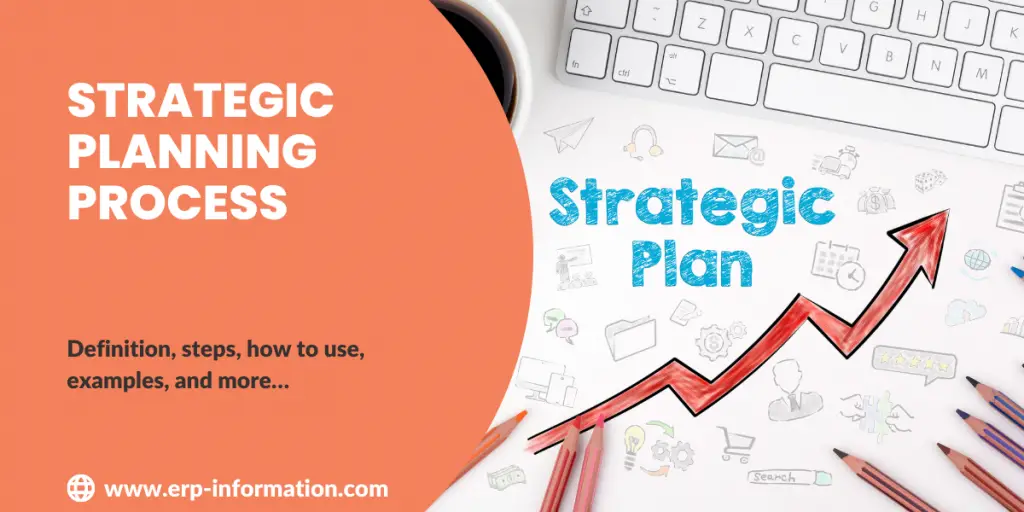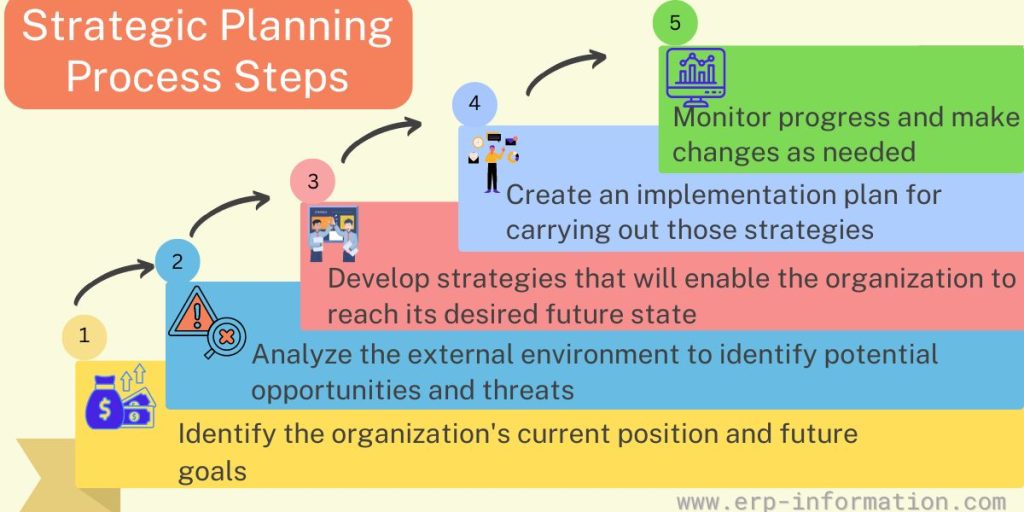Strategic planning is a process that helps out organizations achieve their desired future state. Strategic planning aims to create a roadmap to help the organization reach its goals.
Many steps and models are involved in the strategic planning process, but all have the same aim – helping the organization succeed.
This article will discuss the strategic planning process and explore some of the steps and elements involved. We will also examine the benefits of using a strategic planning process and outline some key principles that guide successful planners.
What is the strategic planning process?
Strategic planning is a process to help organizations create a roadmap to reach their desired future state. The strategic planning process aims to set overall goals and objectives, identify strategies for achieving them, and then ensure that those strategies are effectively implemented.
Strategic planning process steps
1. Identify the organization’s current position and future goals
Strategic planning will start by analyzing the company’s current situation and goals.
- An up-to-date strategic plan is essential to success as it provides a roadmap to reach the desired destination and anticipates potential challenges.
- A strategic plan will help an organization understand where they are now, determine where they want to go, and develop a plan of action with tangible objectives, measurable outcomes, and timelines for success.
- By engaging in strategic planning processes, an organization can properly identify its current position and develop sound, achievable goals for the future.
2. Analyze the external environment to identify potential opportunities and threats
Strategic planning is a second step that begins with a thorough analysis of the external environment to identify potential opportunities and threats.
- Companies must consider changes in technology, customer preferences, competitive landscape, and other external influences that may impact their operations.
- This process is used to detect current and emerging trends, forecast challenges and opportunities, develop strategic alternatives, evaluate risks related to the strategic plan, and formulate strategic objectives.
- Monitoring the external environment is critical in helping create a competitive advantage and staying ahead of the curve when adapting to market trends.
- Ultimately, strategic planners need to stay informed about external factors to anticipate business world changes effectively.
3. Develop strategies that will enable the organization to reach its desired future state
The third step is developing a strong strategy to complete future desires.
- This process involves forming strategic objectives, analyzing their feasibility, and incorporating them into a plan.
- A strategic plan should address the organization’s resources and goals and how they can be most effectively achieved.
- To ensure success, organizations must develop strategies that prioritize their objectives and identify potential threats or opportunities to leverage efficiently.
- Organizations can confidently plot their path to meeting their desired future state and achieve success through effective strategic planning.
4. Create an implementation plan for carrying out those strategies
The fourth step is the implementation plan. Creating a comprehensive and detailed implementation plan is important for implementing strategic plans successfully.
- This plan should include an idea of how long each strategy will take to be implemented, clear steps on what needs to be done for its success, who will be involved in the process, and any resources that may be needed.
- After creating this plan, it is important to regularly evaluate progress to ensure that strategic plans stay on track.
- Ultimately, having a plan will make it much easier for strategic goals to be achieved effectively.
5. Monitor progress and make changes as needed
Last but not least, monitor the progress.
The strategic planning process should be viewed as something other than a one-time event. Instead, it needs to be an ongoing process to ensure success.
- To reach goals and achieve strategic objectives, it is essential to monitor progress along the way and make changes as needed.
- This could include running periodic scans of the external environment for new opportunities or potential threats.
- It offers internal reviews of strategic projects to identify areas that need additional attention.
- Setting up triggers for regular reviews of metrics performance versus goals and assessing team morale by conducting surveys on new initiatives.
- Taking these precautions as part of a strategic planning process is key to optimizing performance and efficiency.
Models used in the strategic planning process
There are a variety of models that can be used to help guide this process. Some of the most popular include
- SWOT(Strengths, Weaknesses, Opportunities, and Threats) analysis,
- PESTLE (Political, Economic, Social, Technological, Legal, and Environmental) analysis,
- Porter’s Five Forces Model,
- Balanced Scorecard.
- Gap planning
- OKRs(Objectives and key results)
- Blue ocean strategy
- VIRO Framework and many more
Each of these models provides a different approach to identifying opportunities and threats that may impact an organization’s ability to reach its goals.
How to use strategic planning effectively?
- The key to successful strategic planning is ensuring that all steps are carried out promptly and that appropriate resources are allocated to each step.
- Furthermore, ensuring that the strategies developed through the process are realistic and achievable is important.
- It is also crucial to involve stakeholders in all aspects of the process to allow for their input and feedback.
Examples of successful strategies
Implemented through a strategic planning process While it is impossible to list every successful strategy implemented through a strategic planning process, some of the most well-known examples include
- Coca-Cola’s global expansion strategy
- Toyota’s lean production system
- Apple’s iPod product launch.
These strategies were developed through careful analysis, consideration of various external and internal factors, and input from stakeholders.
The importance of evaluation in the strategic planning process
While creating an implementation plan for carrying out strategies is important, evaluating progress and making changes as needed is essential.
- Evaluation should be conducted regularly throughout the process to ensure that strategies achieve desired results and resources are allocated appropriately.
- Furthermore, an evaluation can help identify areas that need improvement or potential opportunities and threats in the external environment.
Conclusion
In conclusion, strategic planning is essential for organizations looking to stay ahead of the competition and achieve their goals. Therefore, it is important to involve stakeholders in the process and evaluate progress regularly.
With the right approach, a strategic planning process can be used to ensure that organizations are properly prepared for the future.

